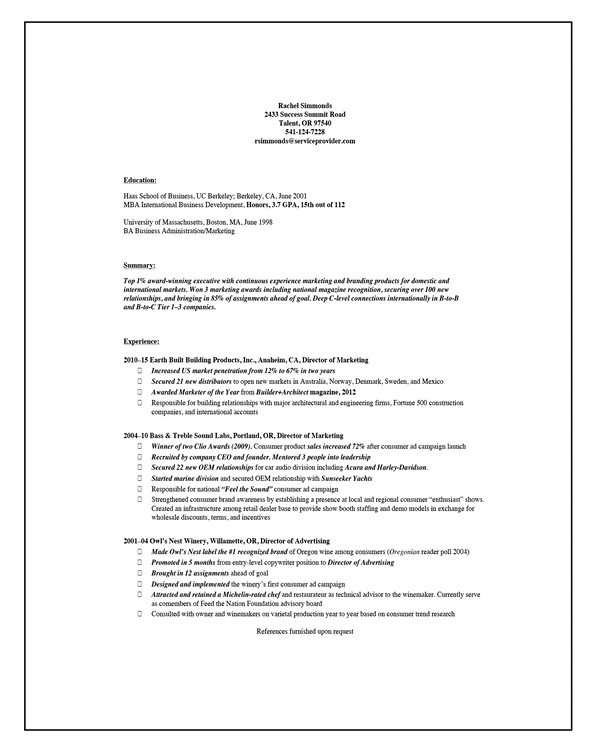Chapter 13
Power Résumé Writing
“How many people live on the reputation of the reputation they might have made!”
—Oliver Wendell Holmes
Your résumé is a portrait of you, a picture painted in words. But an article published in March 2012 entitled “What Your Resume Is Up Against” by Susan Adams for Forbes.com reports that recruiters spend an average of just 6.25 seconds looking at a candidate’s résumé before deciding whether he or she is a fit for a job. That means your résumé has to be more than a work of art; it has to be a precision tool, laser-focused on getting a manager’s attention.
How do you do that? Make sure the most compelling things about you are placed where they’ll get noticed.
Insider Secret #13:
Recruiters and hiring managers probably won’t read every word of your résumé. You have just seconds to get their attention, make an impression, and get an interview.
On your résumé, the first two to four bullets under each entry—each position you’ve held or company you’ve worked for—should speak to your results. The next two bullets should speak to your process and your relationships. Remember: these three elements—results, process, and relationships—are the ones that do the heavy lifting during the interview itself. Doesn’t it make sense to put them at center stage on your résumé?
Let’s say you worked for a large electronics firm. The following are examples of the kind of information that should be included in the first two to six bullets under that listing:
- Received top-level performance ratings every year. Completed all projects 10 percent ahead of time and 15 percent under budget
- Ranked number one account manager in the Northeast for the full year, 2007, 2006, 2005
- Ranked in top 5 percent of achievement
- Won the largest number of new accounts companywide, 2004–2006
- Top engineer
- Top 1 percent recognitions for my contribution to research
- Won Employee of the Month, fall of 2007
The next two bullets under this job listing should deal with your process and your relationships:
- Logged 20 percent more research hours than anyone in the department (Process)
- Personally mentored by Alton Haines, senior vice president of engineering (Relationships)
Now you’ve put the critical components of your résumé where they’re most likely to be seen and noticed, and you’ve done it in a way that takes just seconds to read and absorb. People don’t want long stories. When I see a résumé with long stories but no results, I know that candidate is trying to pull the wool over my eyes. (To be fair, maybe they’re just uneducated in the REAPRICH method.) Any good recruiter or good manager will spot fluff and filler on a résumé.
So, either you have results or you have to get them. If you don’t have specific results or ways to show how you’ve differentiated yourself, you really need to stop at this point in your career and ask why. Why have I not put more time in? Why have I not differentiated myself? If you want to move up the ranks, if you want to be elite, just doing what’s expected won’t get you there. I’m not suggesting you have to work eighty hours a week and burn out. I am suggesting that you have to put in whatever time it takes to create a “wow factor.”
Once you have that “wow factor,” make sure it’s front and center. For instance, people always seem to put awards at the bottom of their résumés. What a huge mistake! Managers want to see your awards under each company listing. Some people leave it off altogether! They say, “Oh, I feel like I’m being arrogant if I put my awards on there.” No, no, no. You’re seeking a job, competing with anywhere from a hundred and fifty to ten thousand other people. You must be willing to show how you are different, better, and accomplished!
Many job seekers ask me whether it’s absolutely essential to include an objective. If you’re early in your career or changing jobs, an objective near the top of your résumé will help people understand what you’re looking for. (See next page for experience examples from a power résumé.)
Some people lead with education, possibly because of the mistaken notion that things should be listed chronologically on a résumé. I say your educational background should only be put in a place of prominence if you have an advanced degree with honors or are applying for a position within academia. Otherwise, put it at the bottom where it can be found by those who want a deeper look into your background but won’t deflect attention away from important current achievements.

Sample Résumé Format
Power Résumé Worksheet
- Jot down some ideas for enhancements you could make on your own résumé based on what you’ve learned. Remember, first highlight three results, then process, and finally relationships.
- Now that you’ve brainstormed some ideas, go update your résumé!